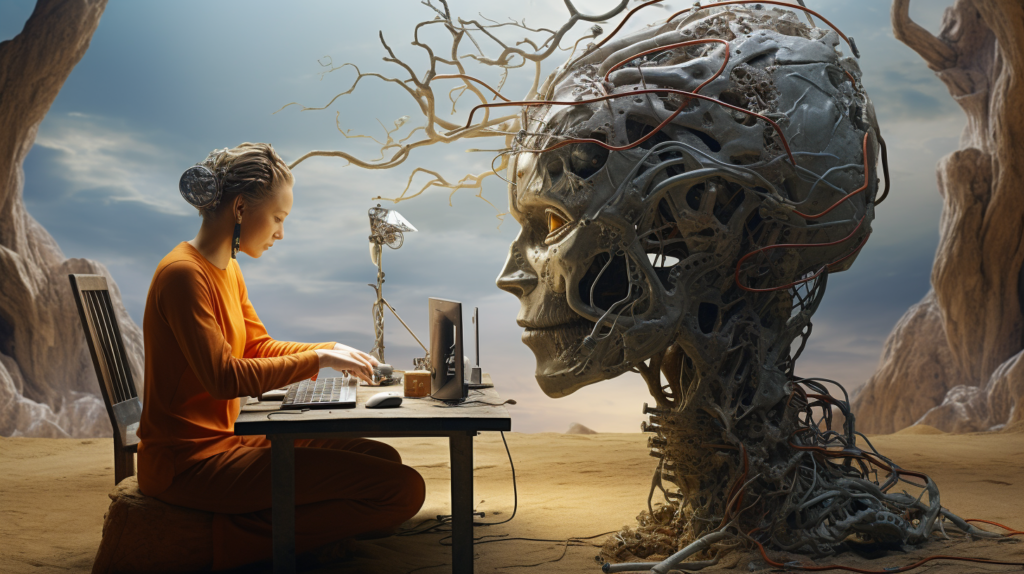
As artificial intelligence (AI) continues to advance, its impact on content creation becomes increasingly profound. AI-driven tools are now capable of generating articles, creating graphics, composing music, and producing videos. This technological evolution raises critical questions about the future of content creation: Can AI replace human creators? What are the strengths and limitations of AI compared to human creativity? This article explores these questions, examining the balance between human touch and machine precision in content creation.
The Power of AI in Content Creation
AI’s capabilities in content creation stem from its ability to process vast amounts of data, identify patterns, and generate content based on these patterns. Here are some of the key benefits of using AI in content creation:
1. Efficiency and Speed
AI can generate content much faster than humans. Automated tools can produce articles, social media posts, videos, and other forms of content in minutes or even seconds. This rapid production can be especially beneficial in industries where time is a critical factor, such as news reporting or social media marketing.
- Example: AI tools like OpenAI’s GPT-3 can generate a full-length article in seconds based on a few input prompts, significantly reducing the time needed to create content from scratch.
2. Consistency and Accuracy
One of AI’s significant advantages is its ability to maintain consistency and accuracy. AI can follow predefined rules and guidelines to ensure that the content adheres to a brand’s voice and style, minimizing errors and inconsistencies.
- Example: Grammarly uses AI to check for grammatical errors, style issues, and tone, ensuring that written content is consistent and error-free.
3. Data-Driven Insights
AI can analyze vast datasets to provide insights into audience preferences, trending topics, and content performance. This data-driven approach allows creators to tailor their content strategies to better meet audience needs and optimize engagement.
- Example: Tools like BuzzSumo leverage AI to analyze social media trends and identify the most engaging content topics and formats.
4. Personalization at Scale
AI can personalize content experiences for individual users by analyzing their behavior, preferences, and interactions. This capability enables content creators to deliver highly targeted and relevant content to their audiences.
- Example: Netflix uses AI algorithms to recommend shows and movies to users based on their viewing history and preferences, creating a personalized entertainment experience.
The Human Touch: Creativity, Emotion, and Nuance
Despite AI’s impressive capabilities, human content creators bring unique qualities that machines cannot replicate. Here’s why the human touch remains essential:
1. Creativity and Originality
Humans possess an innate ability to think creatively and generate original ideas. This creativity is crucial for developing unique and compelling content that resonates with audiences on a deeper level.
- Example: The imaginative storytelling in Pixar movies, which often involves complex characters and emotional narratives, is a testament to human creativity.
2. Emotional Connection
Human creators can infuse content with emotion and empathy, building meaningful connections with audiences. This emotional resonance is often what makes content memorable and impactful.
- Example: Nike’s advertising campaigns, which often feature inspiring stories and evoke strong emotional responses, are crafted by human creatives who understand the power of emotional storytelling.
3. Context and Cultural Understanding
Humans have a deep understanding of cultural contexts, social norms, and subtleties that AI may overlook. This cultural sensitivity is vital for creating content that is relevant, respectful, and effective across different audiences.
- Example: Content addressing sensitive social issues requires a nuanced understanding of cultural contexts and emotional intelligence that AI currently lacks.
4. Ethical Considerations
Human creators can navigate ethical dilemmas and make value-based decisions in content creation. They can address sensitive topics with empathy and ensure that content aligns with ethical standards and societal values.
- Example: Journalists often face ethical decisions in reporting, requiring judgment and a moral compass that AI does not possess.
Balancing Human Touch and Machine Precision
The future of content creation is not about choosing between human creators and AI but finding a balance that leverages the strengths of both. Here are some strategies for achieving this balance:
1. Augmenting Human Creativity
AI can handle repetitive and time-consuming tasks, freeing up human creators to focus on higher-level creative work. This augmentation allows for more innovative and thoughtful content.
- Example: AI can generate first drafts of articles or design templates, which human creators can then refine and personalize.
2. Enhancing Collaboration
AI-driven tools can facilitate collaboration by providing data-driven insights, streamlining workflows, and enabling real-time feedback. This collaborative approach can lead to more efficient and effective content production.
- Example: Collaborative platforms like Adobe Creative Cloud integrate AI tools to assist in the creative process, allowing teams to work together more seamlessly.
3. Personalizing Content
AI can help human creators deliver personalized content experiences by analyzing user data and preferences. This personalization enhances audience engagement and ensures that content is relevant and targeted.
- Example: E-commerce websites use AI to personalize product recommendations and marketing messages based on user behavior and preferences.
4. Ensuring Quality and Compliance
AI can assist in maintaining content quality and compliance by identifying errors, ensuring adherence to guidelines, and detecting potential issues such as plagiarism or biased language. Human oversight remains crucial to validate and refine AI-generated content.
- Example: AI tools can flag potentially offensive or inappropriate content, but human reviewers are needed to make final decisions and provide context-sensitive judgments.
The integration of AI in content creation is transformative, offering unmatched efficiency, accuracy, and data-driven insights. However, the human touch remains indispensable for creativity, emotional connection, cultural understanding, and ethical considerations. The future of content creation lies in the harmonious integration of human and machine capabilities. By leveraging AI to augment human creativity and working collaboratively, content creators can produce high-quality, engaging, and impactful content. This synergy will shape the evolving landscape of content creation, ensuring that both human ingenuity and machine precision contribute to the advancement of the field.